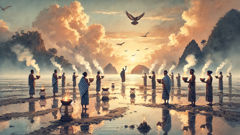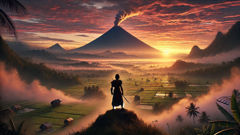Introduction
Before the first bamboo cracked open and before the first dew trembled on the leaves of what would later be called the isles of the Visayas, there was a deep, wide world in which two kin reigned: the Sky, a vast blue elder who stretched from horizon to horizon, and the Sea, a living mirror that swelled and sighed with hunger and longing. The Sky kept watch like a patient guardian, sprinkling stars as seeds and cradling the moon, while the Sea heaved with the memory of journeys not yet made. For a long while they lived without quarrel, trading whispers of cloud and current, learning each other's moods in a wordless language. But kinship alone could not settle a seed of desire that grew within both: the Sky wanted the bright attention of small, hard places to rest upon — islands with faces, trees to hold its rains; the Sea wanted the Sky's soft blessing to make gentle harbors and safe coves where its children could hide. The world that followed was born from that shared wish and from the first sharp voice of disagreement, for what kin cannot ask for more than what kin are willing to lend? This is the story the elders tell beside firelight, the one that bends into song at dawn when fishermen push their boats into glassy water, the one that names the reason for tides and thunder, for islands that rise like gentle fists from the ocean. It is a tale of arguments that become geography, of battles that craft bays, and of final reconciliations that teach the people how to live with the rhythms of wind and wave. In these words the Visayan land finds its beginning: not as a neat creation, but as a compromise between two mighty hearts. Listen then—the sea and the sky once loved and once warred, and their quarrel made the world.
The First Argument: How Islands Were Carved
When the Sky first brushed its robes against the Sea, it left ribbons of mist that the Sea folded into waves. They greeted each other with long sighs and poems of weather. But the Sky grew restless. "Give me places to rest my calves," Sky said, spread wide enough to hold thunder. "Give me cliffs and trees where I can hang my rain like beads and watch the small animals run." The Sea listened and replied with currents and secret hums. "I will give you coves and shoals," Sea promised, "but I will not lose my breath. I will not be hollowed into pools for your vanity. I have my children—big fish, small fish, the deep things—and they must have places to roam." The two argued until their voices pulled the horizon taut.

The first great contest was not like human fights. It took the form of tides and tempests, of cloud-pressing and ocean-pushing. Sky threw long lightning like woven knives and made thunder to test the Sea’s patience. Sea answered with swells that towered and unfurled, dragging sand and stone into new shapes. Where a bolt struck, Sea hardened its surface into a spine; where the Sea rose in a great swell, Sky would drop down a basin of clouds that settled into the backs of islands. Stones gathered like gossip; sand clung until it became land. The first islands came into being as Sky and Sea hurled their wills into one another—a violent crafting that left scars and wonders.
From the collision of wind and water sprang the Archipelago’s early bones: a jag of limestone here, a crescent of black rock there, crescent bays and sheltered lagoons where newborn trees took root. The first groves were small and stubborn, clinging to pockets of soil that the Sea, in a rare gentleness, exhaled like a mother. The Sky, stating its preference for high places, pushed up promontories and softened them with mists so that ferns and orchids could unroll their leaves. Where the Sky laughed, the land became high cliffs that shone at sunrise. Where the Sea sang, the shore became a gentle bead of pebbles and shells.
But the birth of islands bore a cost. In places where Sky’s anger burned bright and thin, the Sea bore bitter cold and swallowed entire ridges, leaving caverns and reefs that would later become both refuge and danger for seafolk. The elders say that the reefs are remnants of the Sea's stubborn defense—valleys once lined with coral that now hold the bones of travelers and the bright scales of fish. It was in this time, in the first years of the contest, that humans—small, curious, and newly made from island clay and the breath of wind—stepped upon land. They found themselves in a world tender and savage, where weather could pluck away a house or gift a harvest within the space of a moon.
The people learned to watch the signs. They learned that the Sky's mood could be read in the curve of a cloud and the position of the sun, and that the Sea revealed its will in the rhythm of tides and the color of the water. They built boats that could speak both languages, hulls carved with songs that asked permission from the Sea and offered thanks to the Sky. They planted root-crops in terraces that the Sea could not reclaim, and they hung wind chants in trees so Sky would know their faces. This was how the islands became home: through attention, through tending, and through the slow making of rituals that eased the quarrel between the two great powers.
As centuries folded like sails on a mast, the stories of the first argument took names and shapes. The Sky was called Kanlaon in some whispers, a keeper of rains and storms; the Sea was called Litan, keeper of currents and depth. The people gave them acts and temperaments to remember distinctions: Sky brought harvest-sweet rains and terrible lightning; Sea gave fish for the table and sudden floods that could swallow a village without a sound. In songs and tattoos and pottery, the battle became a map. Mothers traced it on the bellies of newborns with ash, reminding them of where they came from and what would always be expected: to honor both the ceiling of air and the floor of water, to know that their luck would rise and fall with tides and cloudbanks. Thus the islands were not merely land; they were stories and promises between Sea and Sky and the small, listening people between them.
Reckoning and Reconciliation: Tides, Seasons, and the People’s Pact
After ages of throws and counterthrows, Sky and Sea found their war exhausting. Their tempers cooled not because one had fully subdued the other but because both had been changed by the very things they had unleashed. The islands, now many, had voices of their own: soil that warmed under sun, groves that sang when wind passed through leaves, and beaches that learned the footfalls of humans. These small presences brokered a truce the only way small things can—through need and ceremony.

It was not the Sky’s pride nor the Sea’s pride that ended the fury; it was the cry of a child. A newborn—tiny as a crab’s claw and bright as early fruit—had been born under a roof of woven palm into a village between the two powers. The child’s first breaths were a small song that caught in the Sky's lower clouds, and the Sea held back its tide for the first time as if to listen. The elders called a great meeting where fishermen and children, mothers and priests met on the longest sandbar that appeared between tides. They brought gifts: woven garments soaked in rain and shells polished by the surf. They sang and danced a kind of slow apology and a reminder that they belonged to both realms. The Sky and the Sea, hearing the human chants that had been shaped by their earlier quarrels, discovered a new feeling—curiosity about how small lives adapted to their largeness.
Thus began the Pact of Listening. The elders say that under this pact, Sky agreed to temper its lightning so that it would give warning before it struck, and Sea agreed to move gently around harbors and not swallow safe coves without reason. In exchange, the people promised to honour each cycle that Sky and Sea demanded: the rebuilding after storms, the taboos against taking certain fish in certain seasons, the rituals performed at reef edges to ask forgiveness. These promises were never meant as domination but as a practical accounting of mutual survival. When the people kept their side—when they mended nets, offered first harvests to the breezes, named the stars correctly—the Sky and Sea kept theirs.
From the Pact of Listening grew the festivals that stitched the islands together. At the beginning of the rainy season, villagers would wade to knee-deep water and sing to the Sky for measured rains, while priests poured libations into small bowls set upon raft-like platforms to the Sea. On other days, when the wind needed coaxing, the people burned bundles of aromatic root to remind Sky of their faces. The motions looked like simple superstitions to outsiders, but in the telling of this myth they are framed as the everyday diplomacy that kept disasters at bay. Fishing taboos, for example, became ways to let the Sea replenish its own children; cliffside offerings taught Sky restraint in its thunder. The community learned the art of listening—an art the gods did not always possess.
The reconciliation also gave shape to moral lessons. The myth taught that conflict could create beauty—like islands—and also that violence without remembering the small ones it affects will always create scars. That is why the Sea bears reefs that can be treacherous and why the Sky keeps sudden squalls; they are reminders that even reconciled kin must keep promises. Young people were taught to speak clearly, to ask before taking, and to carry a quiet humility in their ways, because the same forces that made provision could, if offended, undo it.
Within this framework the Visayan people discovered practical knowledge: the art of reading winds, the calendar of tides, and the ways of planting root crops that survive storm and salt. Songs encoded maps of currents and the locations of safe channels; lullabies contained weather proverbs useful for sailors; tattoos indicated family histories of negotiations with particular reefs or favored wind patterns. Elders whose faces were mapped with sun-lines carried songs whose verses referenced episodes of the ancient quarrel as a way to teach children where the islands had come from and how to behave. The myth was pedagogical as much as it was poetic—it taught navigation, respect, and a sense of belonging anchored to place.
And so the Sea and the Sky, still kin but tempered in their dealings, continued to shape seasons and tides in patterns both precise and capricious. Each harvest or storm became a note in a long communal ledger. Whenever a new island rose or a reef shifted, the people retold the tale at communal fires; whenever a child was named, the elders recited the method of rescue and pact. The reconciliation did not end all suffering—floods still came, storms still took houses—but it created a structure for how the people would respond, and a language to speak of loss. The myth closes not with absolute victory but with an agreement that recognizes fragility and mutual obligation: the Sky gives rain and the Sea gives fish, and together they frame the human days between tide and dawn. In the retelling, the islands remain alive—limbs knitted from argument and consent—reminding listeners that their world was born from a conversation that could have ended differently had the small voices not learned to be heard.
Conclusion
The Myth of the Visayan Creation Story does not pretend to be a tidy account of cause and effect. Instead, it offers a living map for how people learn to be in a world where forces larger than themselves decide tides and seasons. The battle of Sea and Sky that birthed islands, reefs, and bays is a metaphor and a memory: a recognition that the landscape itself remembers argument and reconciliation. For the Visayan people, this tale has been more than entertainment. It is a guidebook for survival, a ledger of promises, and a hymn to reciprocity. It tells the listener to pay attention—repair nets when the Sea demands, plant terraces where the Sky waters, and hold festivals to bind an agreement in song. It teaches that the scars left by storms are not only wounds but also records of where bargains were struck and that ritual, like good governance, keeps the balance between supply and safety. In modern harbors and on neon-lit ports, the old songs still echo, and fishermen humming the verses know, in an almost forgotten way, the name of the pact their ancestors made. The myth endures because the world it explains endures: islands rising and falling with the long patience of current and cloud, and people continuing to listen and to promise. As long as the Sky drapes and the Sea answers, the story will be told—by elders, by children, by the waves themselves—so that each new generation learns to live between the two great kin whose quarrel once shaped the very edges of their home.













